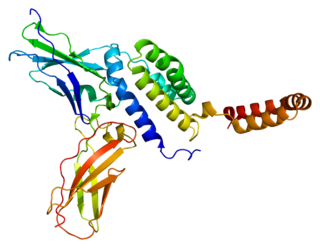Related Research Articles

Interleukin 3 (IL-3) is a protein that in humans is encoded by the IL3 gene localized on chromosome 5q31.1. Sometimes also called colony-stimulating factor, multi-CSF, mast cell growth factor, MULTI-CSF, MCGF; MGC79398, MGC79399: after removal of the signal peptide sequence, the mature protein contains 133 amino acids in its polypeptide chain. IL-3 is produced as a monomer by activated T cells, monocytes/macrophages and stroma cells. The major function of IL-3 cytokine is to regulate the concentrations of various blood-cell types. It induces proliferation and differentiation in both early pluripotent stem cells and committed progenitors. It also has many more specific effects like the regeneration of platelets and potentially aids in early antibody isotype switching.
Interleukin 5 (IL-5) is an interleukin produced by type-2 T helper cells and mast cells.

The common gamma chain (γc), also known as interleukin-2 receptor subunit gamma or IL-2RG, is a cytokine receptor sub-unit that is common to the receptor complexes for at least six different interleukin receptors: IL-2, IL-4, IL-7, IL-9, IL-15 and interleukin-21 receptor. The γc glycoprotein is a member of the type I cytokine receptor family expressed on most lymphocyte populations, and its gene is found on the X-chromosome of mammals.

Interleukin 11 is a protein that in humans is encoded by the IL11 gene.

Interleukin 20 (IL20) is a protein that is in humans encoded by the IL20 gene which is located in close proximity to the IL-10 gene on the 1q32 chromosome. IL-20 is a part of an IL-20 subfamily which is a part of a larger IL-10 family.
Type I cytokine receptors are transmembrane receptors expressed on the surface of cells that recognize and respond to cytokines with four α-helical strands. These receptors are also known under the name hemopoietin receptors, and share a common amino acid motif (WSXWS) in the extracellular portion adjacent to the cell membrane. Members of the type I cytokine receptor family comprise different chains, some of which are involved in ligand/cytokine interaction and others that are involved in signal transduction.

Glycoprotein 130 is a transmembrane protein which is the founding member of the class of tall cytokine receptors. It forms one subunit of the type I cytokine receptor within the IL-6 receptor family. It is often referred to as the common gp130 subunit, and is important for signal transduction following cytokine engagement. As with other type I cytokine receptors, gp130 possesses a WSXWS amino acid motif that ensures correct protein folding and ligand binding. It interacts with Janus kinases to elicit an intracellular signal following receptor interaction with its ligand. Structurally, gp130 is composed of five fibronectin type-III domains and one immunoglobulin-like C2-type (immunoglobulin-like) domain in its extracellular portion.

The interferon-gamma receptor (IFNGR) protein complex is the heterodimer of two chains: IFNGR1 and IFNGR2. It binds interferon-γ, the sole member of interferon type II.

Interleukin 6 receptor (IL6R) also known as CD126 is a type I cytokine receptor.

Interleukin 1 receptor, type II (IL-1R2) also known as CD121b is an interleukin receptor. IL1R2 also denotes its human gene.

Interleukin-10 receptor subunit alpha is a subunit for the interleukin-10 receptor. IL10RA is its human gene.

Interleukin 5 receptor, alpha (IL5RA) also known as CD125 is a subunit of the Interleukin-5 receptor. IL5RA also denotes its human gene.

Interleukin 9 receptor (IL9R) also known as CD129 is a type I cytokine receptor. IL9R also denotes its human gene.

Interleukin 11 receptor, alpha subunit is a subunit of the interleukin 11 receptor. IL11RA is its human gene.

Interleukin 20 receptor, alpha subunit, is a subunit of the interleukin-20 receptor, the interleukin-26 receptor, and the interleukin-24 receptor. The interleukin 20 receptor, alpha subunit is also referred to as IL20R1 or IL20RA. The IL20RA receptor is involved in both pro-inflammatory and anti-inflammatory responses, signaling through the JAK-STAT pathway.

Interleukin 20 receptor, beta subunit is a subunit of the interleukin-20 receptor and interleukin-22 receptor. It is believed to be involved in both pro-inflammatory and anti-inflammatory responses.

Interleukin 3 receptor, alpha (IL3RA), also known as CD123, is a human gene.
The interleukin-5 receptor is a type I cytokine receptor. It is a heterodimer of the interleukin 5 receptor alpha subunit and CSF2RB.

The Interleukin-2 receptor alpha chain is a protein involved in the assembly of the high-affinity Interleukin-2 receptor, consisting of alpha (IL2RA), beta (IL2RB) and the common gamma chain (IL2RG). As the name indicates, this receptor interacts with Interleukin-2, a pleiotropic cytokine which plays an important role in immune homeostasis.

Interleukin-7 receptor subunit alpha (IL7R-α) also known as CD127 is a protein that in humans is encoded by the IL7R gene.
References
- ↑ Chérel M, Sorel M, Lebeau B, Dubois S, Moreau JF, Bataille R, Minvielle S, Jacques Y (1995). "Molecular cloning of two isoforms of a receptor for the human hematopoietic cytokine interleukin-11". Blood. 86 (7): 2534–40. doi: 10.1182/blood.V86.7.2534.bloodjournal8672534 (inactive 2024-04-02). PMID 7670098.
{{cite journal}}: CS1 maint: DOI inactive as of April 2024 (link)